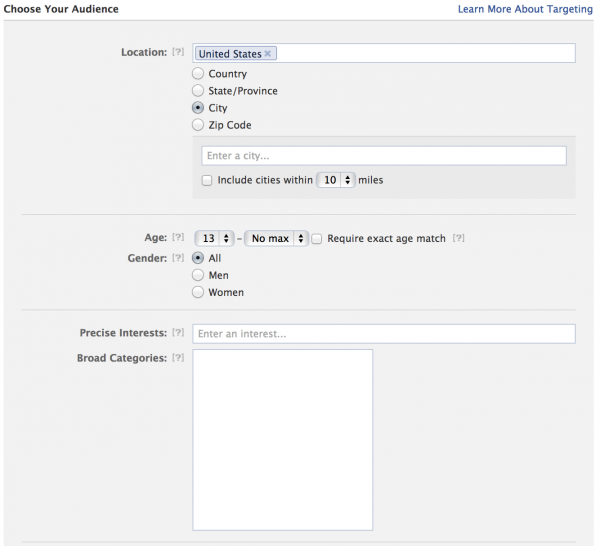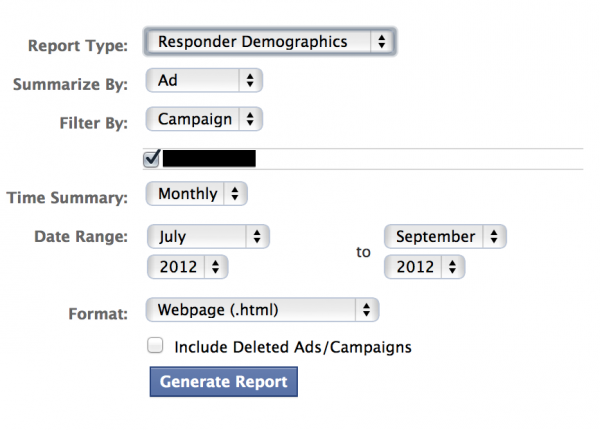Using Social Ad Metrics & Messaging To Shape Your Local Content Strategy
Understanding how your message resonates on social media can be one of the key factors in making sure your content resonates with the community you’re targeting. When you integrate local targeting and messaging into the mix, it can make for a strong content campaign that gives you plenty of metrics and data to review, tweak […]
Understanding how your message resonates on social media can be one of the key factors in making sure your content resonates with the community you’re targeting. When you integrate local targeting and messaging into the mix, it can make for a strong content campaign that gives you plenty of metrics and data to review, tweak and adjust while tracking organic movement..
While this strategy style is very calculating, with tremendous ability for link generation, it’s not something that is scalable for movement if you’re a one person team.
To demonstrate this, we’ll primarily review integrating Facebook ad performance into your overall content strategy. As an example, we’ll use a brick and mortar business with multiple locations all over the US that is looking to potentially increase organic visibility in certain cities where localization is apparent.
Like with any strategy example, this should be applied directly to your scenario and used only as a guide to help hone in on target cities and messaging for sculpting content.
Local Visibility Snapshot
There are tools out there that can automate samplings of queries on a geo-level, but for the sake of this article, we’ll assume that there’s some manual querying going on in order to determine how your site is ranking across various metros if you’re a brick and mortar business. That said, the screenshot below is taken from an export from our internal tool to show metro fluctuations.

URL used for example only; Ruby Tuesday is not the actual client / has no affiliation with our company.
I’ve only displayed relevant sample information for this post – a sample of Google rankings from metro to metro, with one key phrase as an example. There’s a lot more data that is reviewed when creating a local content strategy, but to keep this simple, we’ll only display that small portion.
Things to keep in mind:
- If your brick and mortar locations list isn’t that extreme, then set your geo-location to each individual city and make note of where your site is sitting compared to others for phrases with high conversion and traffic percentages.
- If your store exists in a large amount of city locations, then you can start querying by cross-referencing your location with cities that have the highest populations.
- Identify cities where there is heavy localization and your website isn’t competing as strongly as it is in other cities.
- If you’re reviewing multiple buckets of keywords, this can give you a good glimpse of different segments that may be underperforming as a whole, which can be used in brainstorming content.
- Baseline ranking and traffic numbers per city. It would be best to baseline around different buckets, since your content may have relevance to one bucket over the other.
Once you have a strong understanding of where your site is performing across a subset of cities, we can move on to testing social copy to learn what’s resonating in those particular cities. Because social ad copy varies greatly from business to business and across different verticals, the following sections won’t get very in-depth, but will give you a high level view of the steps.
If you’re just becoming familiar with Facebook ads, Marty Weintraub runs through some basic optimization steps for Facebook ad reports here to help you understand what you’re looking at when viewing reports.
Tips For Targeting Demographics
First, run through and setup the normal demographics that you would target for that particular city. Age ranges will generally stay the same, but interests will definitely vary by city.
Also, there’s something to be said for targeting users / fans within the area or those that have an interest in your competitors on Facebook so you can understand what styles of messaging they respond to.
Running CPC test ads over CPM may be useful because you’ll be able to adjust and measure based on those that are clicking and you won’t end up paying for impressions.
- Create a new ad. You can use an existing post if you’re testing out messaging on the page, but I prefer starting with a new ad rather than using post-space.
- Target two cities that have been identified as weak or underperforming when manually checking rankings for a subset of keywords.
- Set your demographic targeting. The messaging section below drilled down into slicing and dicing different messaging with different targets.
- If you’re intending to, setup targeting for fans of your competitors page/interests.
Messaging “Intent”
Your ad copy should run the gamut of your normal A/B testing because what we’re trying to do here is understand what type of messaging resonates with different locations and demographics, then refine and target them using content.
You’ll want to take time to construct various tests that can appeal to not only different emotions, but tie into events or seasons as well.
It makes sense to test different styles of copy for a brick and mortar clothing retailer. For instance, you could create one group that appeals to emotion (want, envy, need) and one group that appeals to practicality with seasonality and events (back to school, winter wear, etc) and then make small subsets within those that are in line with the actual lifestyle and weather of regional locations.
You can also work with marketing messaging material from the brick and mortar that’s targeted to the income/salary groups to make sure you’re using messaging that appeals to different income brackets.
Consider the following points:
- Does your messaging need to vary by location linguistics? Current or potential consumers in the south will have language or phrases that vary semantically from those in the north or on the west coast, for example.
- Are you testing copy by age group? Make sure you’re running multiple ad copies per city for each demographic group.
- What messaging is resulting in the highest conversions (clicks) if you’re running the CPC model?
- Compare clicks/conversions per city and make note of what messaging and styles were resonating in each.
- What “intent” or “lifestyle” were you targeting that resulted in the highest conversions/clicks? Sticking with the clothing store example, were you targeting parents shopping for school? Teenagers shopping for college? Were you focusing on practicality over style? Style over practicality?
- If you’re targeting fans of competitors, are they integrating the messaging within their content that’s driving clicks?
Once you’ve set up the above, you’re ready to let your ads fly and analyze the data that comes back.
When running ad copy, one thing to take time analyzing and pay attention to is the “feeling” being created. I know it’s an overstated fact to say that content can trigger emotions, but that same messaging tone can be used in the copy you’re creating for a specific geo-location, since sentiment and lifestyle vary per location as well.
Following suit of the clothing store example (no pun intended), practicality vs. style in messaging is actually a great example because depending on the area of the city the person resides in and their lifestyle, practicality messaging may overtake “style” messaging. Whereas in other locations (NYC), style may take precedence over practicality. (And yes, that was a huge generalization but I’m allowed to do that because I’m from the great state of NY. :)
Leverage Insights To Sculpt Geo-Targeted Content
Taking the intent and emotions that have encouraged higher click-throughs on social ads can be tricky to integrate into content, but if done correctly it can reach the right audience, with the right message, and encourage sharing and link generation.
Here’s a small sample spreadsheet that can be created to track messaging. The rows will expand with multiple messaging samples, but this is just a rough guide to help you get started with tracking.
The prior research can be integrated into a blogger outreach campaign to gain local links with your content. Using the baseline messaging as a means for brainstorming, you can start formulating ideas and topics that appeal to a certain percentage of current or potential customers in the city that you’re researching.
Here are some additional tips to get you started:
- Sculpt your content while integrating messaging, tone and intent that performed the best through Facebook ads.
- If you’re creating content around messaging that resonated with a competitor’s audience, look to see if that messaging has been incorporated in their content and how it performed.
- Build a targeted outreach list using a mixture of local sites and national publications.
- Reach out to local sites that have decent social engagement and link generation in order to help your message spread.
- Remember, nothing is preventing you from reaching out to local sites that mention or share content from competitors.
- Continue running and testing other messaging with different demographic sets, cities, intent, etc.
- Over time, start analyzing traffic and ranking numbers to see if there’s been any noticeable movement from the initial baseline.
A word about running with practicality vs. style messaging: If you’ve found which ad copy performed the best with the 30-40 year old female demographic in New York City over Arizona, and it’s close to summertime, brainstorming content ideas around the lifestyle of those women, combined with seasonality and practicality for New York City can open the door to great, targeted content creation.
You can then have your content marketing team reach out to local (and national) websites. If this strategy isn’t scalable within your team, or you’re a one person operation, baselining the metrics and traffic will allow you to track incremental progress over time.
Have you integrated local visibility data from Facebook ads to help sculpt organic content for your target audience? If so, in what vertical? Were you a brick and mortar or strictly operating online and working on segmenting content for various locations?
Opinions expressed in this article are those of the guest author and not necessarily Search Engine Land. Staff authors are listed here.
Related stories
New on Search Engine Land


